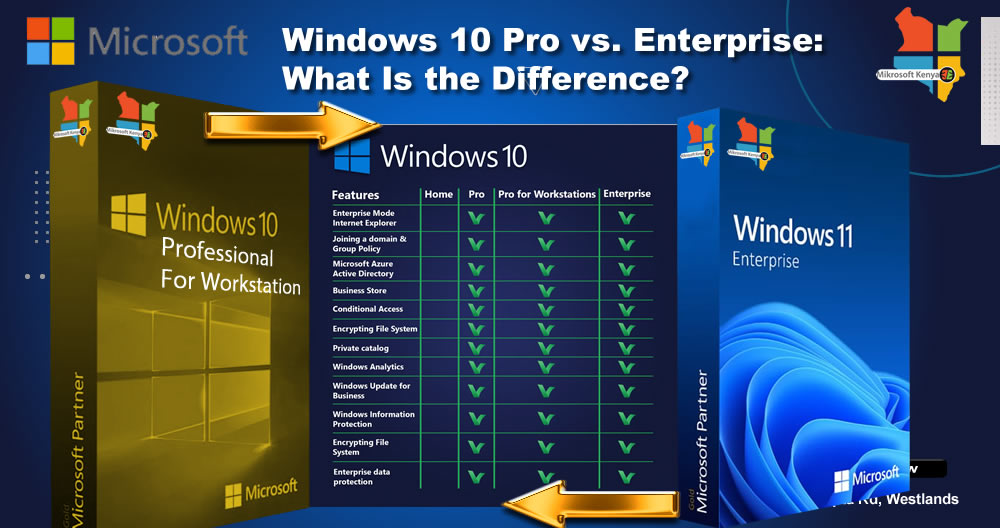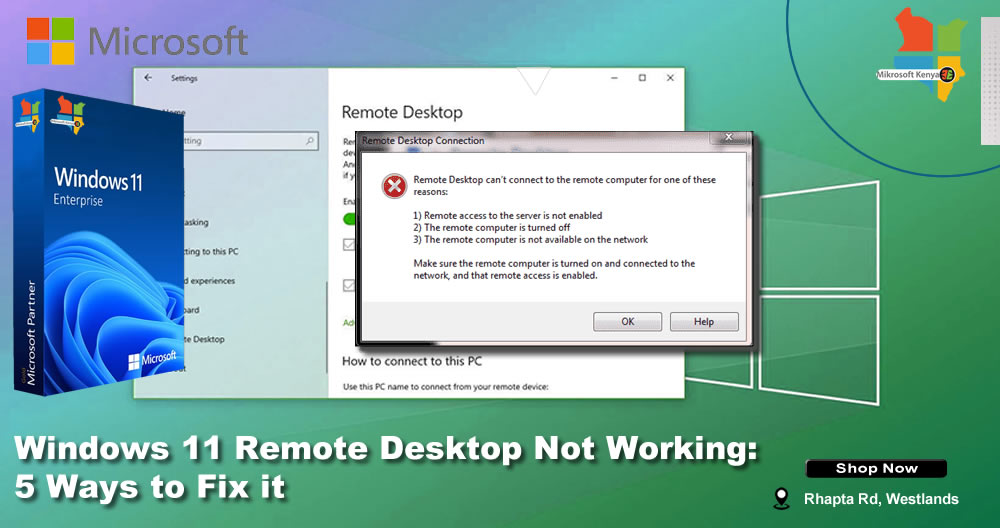

Over four years have passed since the release of Windows 10. With Windows 7 support ending in January 2020, many organizations are overseeing a complete transition to Windows 10. Here we will break down the differences between two business-oriented editions of Windows 10: Windows 10 Pro and Windows 10 Enterprise.
For those considering making the switch to Windows 10 from older versions, this overview will outline key differences between each edition so you can choose the one that will best fit your company’s needs.
Windows 10 Pro vs. Enterprise
One major difference between the editions is licensing. While Windows 10 Pro can come preinstalled or through an OEM, Windows 10 Enterprise requires the purchase of a volume-licensing agreement. There are also two distinct license editions with Enterprise: Windows 10 Enterprise E3 and Windows 10 Enterprise E5. As the chart below shows, E5 offers comparatively more security features than E3. You can find more information on how these editions compare on Microsoft’s website (https://www.microsoft.com/en-us/windowsforbusiness/compare).
Management and Deployment
| Windows 10 Pro | Windows 10 Enterprise E3 | Windows 10 Enterprise E5 | |
|---|---|---|---|
| MDM (Mobile Device Management) | ✓ | ✓ | ✓ |
| AAD (Azure Active Directory) Join | ✓ | ✓ | ✓ |
| Domain Join | ✓ | ✓ | ✓ |
| MAM (Mobile Application Management) | ✓ | ✓ | ✓ |
| Shared PC Mode | ✓ | ✓ | ✓ |
| Microsoft Store for Business | ✓ | ✓ | ✓ |
| Windows Hello Management | ✓ | ✓ | ✓ |
| Kiosk Mode | ✓ | ✓ | ✓ |
| Windows Store Access Management | ✓ | ✓ | |
| CEM (Customer Experience Management) | ✓ | ✓ | |
| Cortana Management | ✓ | ✓ | |
| Microsoft Dynamic Management | ✓ | ✓ | |
| App-V (Microsoft Application Virtualization) | ✓ | ✓ | |
| UE-V (Microsoft User Environment Virtualization) | ✓ | ✓ |
Security and Identity Information
| Windows 10 Pro | Windows 10 Enterprise E3 | Windows 10 Enterprise E5 | |
|---|---|---|---|
| Conditional Access | ✓ | ✓ | ✓ |
| Windows Hello | ✓ | ✓ | ✓ |
| BitLocker and BitLocker To GO | ✓ | ✓ | ✓ |
| Windows Information Protection | ✓ | ✓ | ✓ |
| Direct Access | ✓ | ✓ | |
| Direct Guard | ✓ | ✓ | |
| Credential Guard | ✓ | ✓ | |
| Windows Defender Threat Protection | ✓ |
Analysis and Service Support
| Windows 10 Pro | Windows 10 Enterprise E3 | Windows 10 Enterprise E5 | |
|---|---|---|---|
| Windows Analytics | ✓ | ✓ | ✓ |
| Windows Update for Business | ✓ | ✓ | ✓ |
Windows Basic Features
| Windows 10 Pro | Windows 10 Enterprise E3 | Windows 10 Enterprise E5 | |
|---|---|---|---|
| Remote Desktop | ✓ | ✓ | ✓ |
| Windows To GO | ✓ | ✓ | |
| BranchCache | ✓ | ✓ | |
| Microsoft Desktop Optimization Pack | ✓ | ✓ |
Feature Overview
To understand the above charts a bit better, let’s overview some of these key features.
MDM (Mobile Device Management)
In today’s increasingly mobile business environments, improper use of mobile devices often leads to costly security incidents. Central management of enterprise mobile devices is crucial in subverting these security incidents. MDM is able to monitor all enterprise mobile devices at once, analyze usage data for individual users, and apply appropriate security policies.
Shared PC Mode
This feature allows for the configuration of shared environments for multiple clients.
Microsoft Store for Business
A private store for organizations to manage application configuration, distribution, and creation.
Windows Hello
Offers password-less sign-in using biometric authentication, including facial, retinal, and fingerprint recognition. This feature has become increasingly important as cases of unauthorized third-party use of devices continue to rise.
Cortana
The virtual assistant loaded in Windows 10. Compatible with multiple languages, Cortana uses voice commands to assist in daily business tasks, including function calls and web searches.
AppLocker
Utilizes unique identities of files to create rules that permit or deny the running of select applications. These rules can be specified at the group or user level. This feature is vital in restricting access to important files and applications and improving security.
App-V (Microsoft Application Virtualization)
Allows for the virtualization of application execution environments. Separating the application environment from the client operating system greatly improves security and management efficiency.
UE-V (Microsoft User Environment Virtualization)
Captures, saves, and manages Windows 10 OS and application settings.
Direct Access
Allows for remote access to virtual environments.
Windows Information Protection
Prevents data leaks via email, etc. and improves security. This feature helps to maintain corporate confidentiality, as data leaks via emails sent in error are exceedingly common.
Credential Guard
Allows for virtualization-based security where access is granted to only privileged systems.
Remote Desktop
Allows users of one Windows 10 device to connect to another Windows 10 device on the same network or internet connection.
Windows To GO
Allows users to create an imaged version of the corporate Windows 10 environment on a USB flash drive and run it from their personal Windows 10-compatible device.
BranchCache
Allows for access to content on remote servers for branch office workers, reducing WAN bandwidth usage and improving application response time.
Microsoft Desktop Optimization Pack
A suite of functions that allow for application virtualization, group policy management, reduction of downtime, and monitoring of rule compliance.
Licensing and Subscriptions
Here we will go over the licensing options for Windows 10 Enterprise.
While Windows typically comes preinstalled with the purchase of a PC, Windows 10 Enterprise OEM has to be purchased and added separately. This additional license is a subscription-based fixed term contract, and assumes that the purchasing PC has an active Windows OEM license. Please note that white box PCs are ineligible for this volume licensing.
Also note that this license includes not only Windows 10 Enterprise privileges, but also that for connection to VDI environments. VDI can provide significant advantages in migrating to Windows 10, as well as in ensuring application compatibility.
Windows 10 Enterprise is loaded with the most widely-used Windows features in corporate environments. At the same time, update policies are subject to change, and enterprises should consider their own use cases regardless of the edition. In migrating from an older version of Windows, carefully compare the features of each edition to determine which is most appropriate for your company’s needs.
Windows 10 Migration Assessment
Before selecting a Windows 10 edition, the first step in any migration plan is an assessment of your IT environment. With Iconic Technologies Software’s SysTrack, you can quickly and accurately collect data on your users’ PC environment to better inform your Windows 10 migration plan. SysTrack addresses hardware and software inventory migration concerns ahead of time, like whether your devices meet the hardware requirements for Windows 10, or whether certain applications or software versions will pose compatibility issues with migration. This allows enterprises to determine the necessary costs and scheduling of the migration process.
In selecting an assessment tool, get the most out of your investment by choosing a tool that can still be utilized after the migration is completed. Iconic Technologies SysTrack is an assessment solution with an intuitive interface for managing desktop and application performance information.
Courtesy of Lakeside Software




